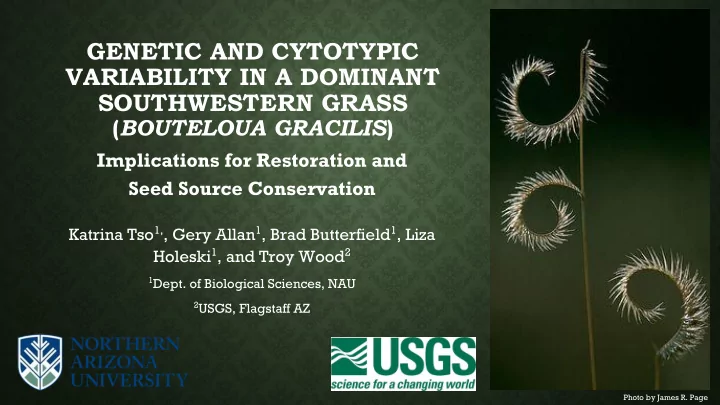

GENETIC AND CYTOTYPIC VARIABILITY IN A DOMINANT SOUTHWESTERN GRASS ( BOUTELOUA GRACILIS ) Implications for Restoration and Seed Source Conservation Katrina Tso 1, , Gery Allan 1 , Brad Butterfield 1 , Liza Holeski 1 , and Troy Wood 2 1 Dept. of Biological Sciences, NAU 2 USGS, Flagstaff AZ Photo by James R. Page
LOCAL ADAPTATION • Local adaptation: • Is likely to influence the response of a species to climate change • May be predictive of the success of cultivated seeds for restoration purposes Bobvilla.com
RESTORATION IN THE SOUTHWEST • Primarily driven by wildfire • 7.2 million AC annually in US (3X AC burned in 1980s) • Forest Service alone spends $3.3 million/year on seeding Peppin et al., 2010 National Interagency Fire Center
CULTIVARS AND NATURAL POPULATIONS • Locally adapted seed recognized USDA for increased restoration success • Cultivated varieties and selection pressure of agriculture: • Selection for large biomass, high seed yield • Potential loss of traits that allow for survival in a variable wildland climate Schroder & Prasse, 2013
OBJECTIVES 1) Genetic structure of Kendrick Park Bouteloua gracilis on the Flagstaff, AZ 7,910 ft Colorado Plateau 2) Correlation with key environmental variables Sevilleta LTER Alamillo, NM 3) Genetic differentiation of 5,020 ft http://sev.lternet.edu/ wild populations and cultivars High Country Garden Santa Fe, NM 7,200 ft http://www.highcountrygardens.com/
STUDY SITE: THE COLORADO PLATEAU • 140,000 sq. miles in the 4- corners region • Sonoran Desert to Alpine, 3,000-14,000 ft • Dominated by semiarid conditions with broad distribution of annual precip • Average of 10” • Low elevations as little as 5” • >8,000 ft., 20”; >11,000 ft, 36” • Variable temperatures • Lower elevations: 20-90 F • Higher elevations: 0-70 F Foos, 1999
STUDY SPECIES: BOUTELOUA GRACILIS • Broadly distributed perennial grass • Variable habitat types from semi-desert grasslands to montane understory • Highly valued species for conservation and rehabilitation • Broad range • Adaptability • Ease of establishment • Year-round forage value A. Hitchcock
GENETIC FINGERPRINTING ANALYSIS • Amplified fragment length polymorphism (AFLP) • Rapid screening technique • Generates anonymous markers throughout the genome • Sampling • 385 individuals • 44 natural sites, 5 cultivars • 3 primer combinations • 100 markers scored • 6 identified as likely under selection
Genetic Structure (AFLP) Cytotype Distribution Butterfield and Wood, 2015 PhiRT= 0.09 PhiRT= 0.17
ENVIRONMENTAL ANALYSIS • Temperature • Mean Annual Temperature • Temperature Seasonality • Precipitation • Mean Annual Precipitation • Precipitation Seasonality • Precipitation Coldest Quarter • Precipitation Driest Quarter
MEAN ANNUAL TEMPERATURE P = 0.0006 P = 0.004 Butterfield and Wood, 2015
P = 0.001 P = 0.02 P = 0.01
GENETIC RESPONSE TO CLIMATE: POPULATIONS CULTIVARS CYTOTYPES
SUMMARY NATURAL POPULATIONS CULTIVATED VARIETIES • 2 genetically distinct • Group with only 5 of 44 populations: natural populations • Colorado Plateau • Off-Plateau • Off Colorado Plateau • Genetic variation not • Genetic variation correlated to correlated to: environment • Environment • Population • Suggested loss of • Cytotype locally adapted traits in • Colonization history; response to adaptive differences in agricultural cytotypes and populations environment
FUTURE RESEARCH & MANAGEMENT RECOMMENDATIONS • Management Recommendations • Future Research • Increased research and utilization of seed transfer • cpDNA analysis, additional sampling, reciprocal zones for this species transplant experiment • New cultivar development specific to Colorado • Use data to: Plateau • develop models to identify seed transfer zones • Frequent introduction of natural gene sources into for this species across the Colorado Plateau cultivars • climate change models to aid in assisted gene flow research and efforts
QUESTIONS?
The preceding presentation was delivered at the 2017 National Native Seed Conference Washington, D.C. February 13-16, 2017 This and additional presentations available at http://nativeseed.info
Recommend
More recommend